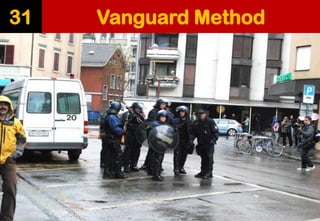40 Agile Methods in 40 Minutes
- 2. Welcome…
- 3. Let’s Go!
- 4. Foundations
- 5. Manifesto for Agile Software Development--
- 6. Manifesto for Agile Software Development-- 17 signatories 2001 agilemanifesto.org Values Principles Signatories
- 7. Scrum1
- 8. Scrum1 Jeff Sutherland / Ken Schwaber 1996 scrumguides.org “A framework within which people can address complex adaptive problems, while productively and creatively delivering products of the highest possible value.” Process Roles Theory Basis for most iterative processes / methods currently in use. Opinion + -
- 10. ScrumBut (ScrumAnd)1a Eric Gunnerson 2006 blogs.msdn.com/b/ericgu/archive/2006/10/13/scrumbut.aspx “We're doing Scrum but...” “We use Scrum and...” Ken Schwaber 2008 kenschwaber.wordpress.com/2012/04/05/scrum-but-replaced-by-scrum-and/ ScrumBut vs ScrumAnd ScrumAnd framework “We use Scrum and we are collaborating and brainstorming within the Scrum Team to increase value every Sprint.” "We're doing Scrum but..." our sprints are 12 weeks long” ScrumBut ScrumAnd
- 12. Extreme Programming (XP) Kent Beck 1996 extremeprogramming.org “Extreme Programming is the first popular methodology to view software development as an exercise in coding rather than an exercise in management.” Principles Values 2 Process Practices + -Practices have become software engineering good practice Opinion
- 13. Crystal3
- 14. Crystal3 Alistair Cockburn 1992 alistair.cockburn.us/crystal+methodologies “Crystal is a family of human-powered, adaptive, ultralight, “stretch-to-fit” software development methodologies… designed to scale by project size and criticality” Methodology: Size vs Criticality Properties + - Exploratory 360 degree Early victory Walking skeleton Incremental rearchitecture Information radiators Strategies
- 15. Dynamic Systems Development Method (DSDM)4
- 16. Dynamic Systems Development Method (DSDM)4 DSDM Consortium 1994 dsdm.org “Incorporates project management disciplines… to ensure… project benefits are clear,… proposed solution is feasible and …solid foundations in place…” Process Deliverables MoSCoW Practice Principles + -
- 18. Feature Driven Development (FDD)5 Jeff De Luca 1997 featuredrivendevelopment.com/ “a recipe for simplified, enhanced and measurable project management: patterns of play that bring success.” Process Parking Lot Practice Best Practices + -
- 20. Adaptive Software Development (ASD) / Adaptive Leadership6 “Adaptive Software Development does not provide a set of prescriptive rules or tasks, but a framework of concepts, practices, and guidelines” Jim Highsmith 1992 adaptivesd.com Lifecycle Characteristics Agents Environments Emergence Complex Adaptive Systems (CAS) Theory + -
- 21. Lean
- 22. Lean / Lean Manufacturing / Lean Enterprise / Toyota Production System7
- 23. Lean / Lean Manufacturing / Lean Enterprise / Toyota Production System7 “Lean uses less of everything compared with mass production… As it inevitably spreads… will change almost everything in almost every industry…” Eli Whitney Taichi Ono James Womack 1850 1936 1990 lean.org Lean Principles Improvement Kata 8 Wastes (Muda) + -
- 25. Lean Software Development7a “Lean uses less of everything compared with mass production… As it inevitably spreads… will change almost everything in almost every industry…” Mary & Tom Poppendieck 2003 poppendieck.com 7 Principles / 22 Tools + -
- 26. Deming System of Profound Knowledge8
- 27. Deming System of Profound Knowledge8 “An effective theory of management that provides a framework of thought and action for any leader wishing to transform and create a thriving organization…” W. Edwards Deming 1939 deming.org Theory of Knowledge Knowledge of VariationSystems Thinking 14 points for management + -
- 29. (Product Development) Flow9 “...the dominant paradigm for managing product development is wrong. Not just a little wrong, but wrong to its very core.” Donald G. Reinertsen 2009 lpd2.com / leanproductflow.com Optimum Batch Size High Delay Cost Job First Failure to correctly quantify economics Blindness to queues Worship of efficiency Hostility to variability Worship of conformance Institutionalization of large batch sizes Underutilization of cadence Managing timelines instead of queues Absence of WIP constraints Inflexibility Noneconomic flow control Centralized control 12 Cardinal Sins 175 Principles + -
- 31. Kanban (Modern Management Methods)10 “...evolutionary change model that utilizes a kanban (small k) pull system, visualization, and other tools to catalyze the introduction of Lean ideas into technology…” David J. Anderson 2010 djaa.com Start with what you do now Agree to pursue incremental, evolutionary change Respect the current process, roles, responsibilities and titles Leadership at all levels Kanban Board 4 Principles 5 Core Properties + -
- 33. Personal Kanban11 “...provides a light, actionable, achievable framework for understanding our work and its context.” Jim Benson / Tonianne DeMaria Barry 2011 personalkanban.com 2 Rules of Personal Kanban Get your stuff ready Establish your value stream Establish your backlog Establish your work in progress limit Begin to pull Reflect 5 Steps + -Throughput
- 34. Lean Startup12
- 35. Lean Startup12 “It's ultimately an answer to the question ‘How can we learn more quickly what works, and discard what doesn't?” Eric Ries 2008 theleanstartup.com 5 Principles Process Popularised + -
- 36. Extensions
- 37. Hybrid Agile (Scrumban, Xanpan, Nonban, Water-Scrum-Fall)13
- 38. Hybrid Agile (Scrumban, Xanpan, Nonban, Water-Scrum-Fall)13 “Using one or more aspects of different methods Xanban Water Scrum Fall Scrumban Nonban
- 39. ScrumPLOP (Pattern Languages of Programs)14
- 40. ScrumPLOP (Pattern Languages of Programs)14 “ScrumPLoP mission is to build a body of pattern literature around… communities, describing… insights, so we can easily share them.” Jeff Sutherland / Jim Coplien 2010 scrumplop.org Pattern Spreadsheet Pattern Map + -
- 42. Enterprise Transition Framework (ETF)15 “…focus of ETF is to allow an organization to implement continuous improvement and to experience change in an empirically controlled way.” Agile42 2014 agile42.com/en/agile-transition/etf/ + - Framework
- 44. Software Faster16 “…Brings agile principles into the 21st century… to think differently about design, architecture, development & testing, operations, automation & team dynamics…” Dan North 2010 dannorth.net 3 ages of agile Avoiding problems Fits in my head Micro services Focussed effort Release mentality is harmful Software: asset or liability Blink estimation Patterns Workshop Agenda Deliberate Discovery + -
- 46. Extreme Manufacturing (XM) (Wikispeed)17 “…Set of technical practices and management principles to go from an idea to a product or service in the customers hands in less than 7 days.” Joe Justice 2008 wikispeed.org Wikispeed Process - +
- 47. Certifications (BABOK / PMI ACP / icAgile / …)18
- 48. 18 PMI-ACP IIBA BABOK Agile Extension PRINCE2 Agile Best Practice ICAgile Certification Certifications (BABOK / PMI ACP / icAgile / …)
- 49. Scale
- 51. Agile Unified Process (AUP)19 “…A simplified version of the Rational Unified Process (RUP)…” Scott Ambler 2005 ambysoft.com/unifiedprocess/agileUP.html Lifecycle Philosophies
- 53. Disciplined Agile Delivery (DAD)19a “…People-first, learning-oriented hybrid agile approach… has a risk-value lifecycle, is goal-driven, is scalable, and is enterprise aware.” Scott Ambler 2012 disciplinedagiledelivery.com Lifecycle Scaling Key Aspects + -
- 55. Enterprise Unified Process (EUP)19b “…a full-fledged software process …is an extension to the solution delivery methodologies such as DAD.” Scott Ambler 1999 enterpriseunifiedprocess.com Lifecycle When to Adopt + -
- 57. Large Scale Scrum (LeSS)20 “…a label to imply regular Scrum plus the set of tips we have seen work in large multiteam, multisite and offshore agile development.” Craig Larman / Bas Vodde 2008 2015 less.works/ + - LeSS (up to 8 teams) LeSS Huge (up to a few thousand people)
- 59. Enterprise Scrum21 “… provide an expanded and more detailed framework foundation of Scrum so that we can use Scrum for business, generic or scalable purposes.” Mike Beedle 2010 enterprisescrum.com Model Business Skin Improvement Cycles + -
- 61. Scaled Agile Framework (SaFE)22 “…Interactive knowledge base for implementing agile practices at enterprise scale... Highlights the individual roles, teams, activities & artifacts necessary to scale agile…” Dean Leffingwell 2007 scaledagileframework.com Framework + -
- 63. @Spotify / Squadification23 “…Scaling using tribes, squads, chapters and guilds” Henrik Kniberg / Spotify 2012 labs.spotify.com Principles + - Approach Engineering Culture
- 65. Nexus Framework24 “…a framework consisting of roles, events, artifacts, and techniques that bind and weave together the work of approximately three to nine Scrum Teams…” Ken Schwaber 2015 scrum.org/nexus Builds on existing Scrum knowledge Builds on Scrum + - Framework 3-9 Teams Nexus Integration Team Integrated Increment Adds “Nexus” to the ceremonies Core Features
- 67. DevOps25
- 68. DevOps25 “a response to the interdependence of software development and IT operations.” Patrick Debois 2009 jedi.be/blog/ Lifecycle Relationship Process Principles - +
- 70. Programmer Anarchy26 “Developer driven development” Fred George 2010 db.tt/4qFljVxU Customer Project Manager Developer Business Analyst Quality Assurance / Test Reduction in Roles Agile Manifesto & XP Values Standups Trust with co location Story narratives Retrospectives Estimates Iterations Results, not blame Mandatory pairing Unit tests, acceptance tests Refactoring Patterns Small, short lived apps Continuous integration Continuous deployment Missing Agile Practices + -
- 71. Mikado Method27
- 72. Mikado Method27 “…a pragmatic, straightforward, and empirical method to plan and perform non-trivial technical improvements on an existing software system.” Ola Ellnestam / Daniel Brolund 2009 mikadomethod.wordpress.com Analogy Mikado Graph + - Method
- 74. Mob Programming28 “All the brilliant people working at the same time, in the same space, at the same computer, on the same thing” Woody Zuill 2012 mobprogramming.org Group work area One computer for programming, all can see Driver/navigator 15 minute rotations Team communication ownership Whole Team Rotation Key Practices Process + -
- 75. TDD / ATDD / BDD / SBE29
- 76. TDD / ATDD / BDD / SBE29 “Begin with the end in mind…” Kent Beck Dan North Gojko Adzic 1994 2006 2011 TDD / ATDD Process Deriving scope from goals Specifying collaboratively Refining specifications Automating tests based on examples Validating frequently using tests Evolve documentation system from specifications with examples SBE Practices + -
- 78. Context Driven Testing30 “…Advocates testing in a way that conforms to the context of the project, as opposed to testing in a way that follows some fixed notion of "best practice." James Bach / Cem Kaner / Brian Marick / Bret Pettichord 2001 context-driven-testing.com Principles Community + -
- 79. Leadership
- 81. Vanguard Method31 “…Means for helping service organisations change from a conventional ‘command-and-control’ design to a systems design.” John Seddon 1985 vanguard-method.com • Managers must know the system before changing it or making decisions within it • Managers shouldn’t control what is said to customers, only front line staff dealing with customers are best placed to understand context • Generalists over specialists • Management by numbers makes performance worse • When managers believe they know best, they inhibit ideas • Improvement requires understanding the true problems, not fixing the problems you think you have • Instead of establishing standards, ensure capability and purpose • “Good enough” is the fast track to being mediocre. Systems thinking is the desire to be perfect • Reports serve the hierarchy, they don’t serve constructive action • Never use the hierarchy to find out what is going on • Be wary of using the hierarchy to solve problems rather than connecting the two parts • Intrinsic motivation over targets • Management’s job is not to exert control through hierarchy with arbitrary measures, management’s job is to achieve real control by working on the system • 95% of a worker’s performance is attributable to the system, management’s job is to work on the system, know the types of demand requests • Standardisation is in effectual in variable outcome work. Economy comes from flow, not scale. • Manage value drives cost out of the system, managing costs drives cost up • Change requires no plan, the only plan is – get knowledge • Economies achieved through less of a common resource are marginal compared to the economies achieved through flow – redesign the services against the demand • Control the organisation with arbitrary measures and in fact, you actually diminish control. Or control the organisation with measures related to purpose, used where the work is done, and you will achieve genuine control, and what’s more your people will innovate. • Understanding the causes of failure demand leads to redesigning services; failure demand is systemic, a product of the system, you can only remove it by changing the system Principles + -
- 82. Holocracy32
- 83. Holocracy32 “…Radically changes how an organization is structured, how decisions are made, and how power is distributed.” Brian Robertson 2006 holacracy.org Process Circle Structure Holacracy Constitution + -
- 84. Rightshifting33
- 85. Rightshifting33 “Improving the effectiveness of knowledge-work businesses/” Bob Marshall 2008 flowchainsensei.wordpress.com/rightshifting/ SDLC – Various Stages of Effectiveness Project Management Effectiveness Marshall Model Stages + -
- 87. Beyond Budgeting34 “…‘Budgeting’ is not used in its narrow sense of planning and control, but as a generic term for the traditional command and control management model” Jeremy Hope / Robin Fraser / Peter Bunce Bjarte Bogsnes 1998 bbrt.org Principles Approach + -
- 89. Radical Management35 “…A way of managing organizations that generates at the same time high productivity, continuous innovation, deep job satisfaction and customer delight. Radical.” Steve Denning 2010 stevedenning.com/radical-management Commit Target Focus Read Their Minds Innovate in Stages Evaluate Customise Partner with Customers Empower Measure Principles Delight The Customer + -
- 90. Stoos Network36
- 91. Stoos Network36 “Uncovering better ways of leading organisations” Stoos Network 2012stoosnetwork.org + - Problems
- 92. Management 3.037
- 93. Management 3.037 “…Help… grow and transform organizations into becoming great places to work.” Jurgen Appelo 2011 management30.com Model Empower People Improve Everything + -
- 95. Drive38
- 96. Drive38 “…The secret to high performance… is the deeply human need to direct our own lives, to learn and create new things, and to do better by ourselves and our world.” Dan Pink 2009 danpink.com Key Points Intrinsic Motivation + -
- 98. Theory of Constraints39 “A chain is no stronger than its weakest link.” Eli Goldratt 1984 goldratt.com Process of Ongoing Improvement Bottlenecks Thinking Process + -
- 99. Cynefin40
- 100. Cynefin40 “a perspective on the evolutionary nature of complex systems, including their inherent uncertainty.” Dave Snowden 1999 cognitive-edge.com Model + -
- 101. Final Thoughts
- 102. Agile ?Raccoon!
- 103. Oath of Non Allegiance--
- 104. Oath of Non Allegiance-- Alistair Cockburn 2010 alistair.cockburn.us/oath+of+non-allegiance I promise not to exclude from consideration any idea based on its source, but to consider ideas across schools and heritages in order to find the ones that best suit the current situation. “ “









































































































